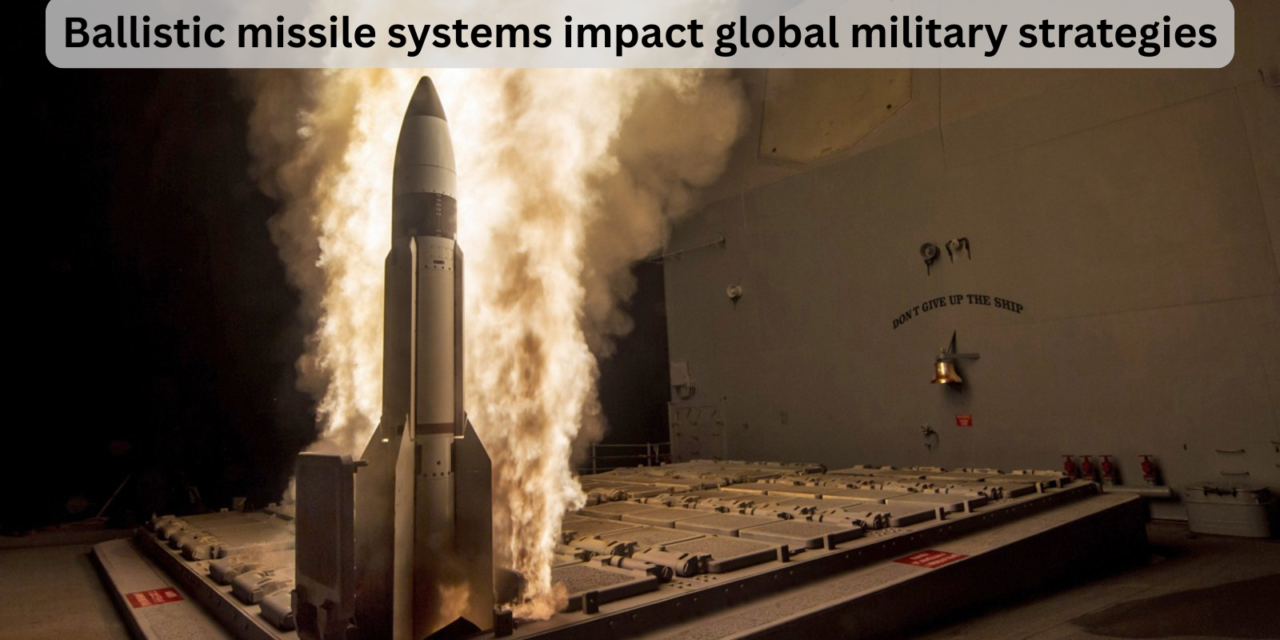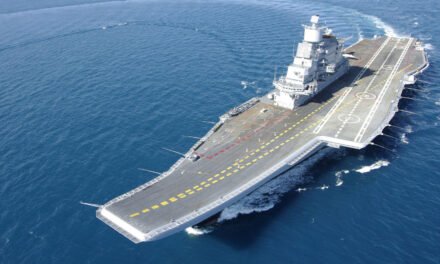Ballistic missile systems significantly impact global military strategies by serving as powerful tools for deterrence, force projection, and strategic dominance. Their versatility and range make them critical assets for both offensive and defensive operations. Here’s how they influence global military strategies:
1. Strategic Deterrence
- Nuclear Triad Role:
- Ballistic missiles, particularly intercontinental ballistic missiles (ICBMs) and submarine-launched ballistic missiles (SLBMs), form a critical component of the nuclear triad, alongside strategic bombers and nuclear submarines.
- Their assured second-strike capability deters adversaries from launching a first-strike attack.
- Psychological Impact:
- The mere possession of ballistic missile systems serves as a deterrent by signaling a nation’s ability to retaliate massively in case of aggression.
2. Force Projection
- Extended Reach:
- The ability to strike targets thousands of kilometers away enables nations to influence geopolitical dynamics beyond their immediate borders.
- Example: Countries use medium-range ballistic missiles (MRBMs) and intermediate-range ballistic missiles (IRBMs) to project power in regional conflicts.
- Show of Strength:
- Missile tests and deployments serve as demonstrations of technological and military prowess, influencing the behavior of adversaries and allies.
3. Quick Reaction and First-Strike Capabilities
- Rapid Deployment:
- Ballistic missiles can be launched within minutes, providing the capability for a rapid response or preemptive strike against emerging threats.
- First-Strike Potential:
- Nations may consider using ballistic missiles in a first-strike scenario to neutralize critical enemy assets, such as command centers, missile silos, and airbases.
4. Dual-Use Versatility
- Conventional and Nuclear Payloads:
- Ballistic missiles can deliver both conventional and nuclear warheads, making them versatile tools for a wide range of missions.
- Example: Precision-guided ballistic missiles with conventional warheads are increasingly used for high-value targets in conventional conflicts.
- Hypersonic Glide Vehicles (HGVs):
- Integration of HGVs with ballistic missile systems enhances their speed, maneuverability, and survivability, complicating defense efforts.
5. Regional Power Balances
- Strategic Competition:
- Deployment of ballistic missiles influences regional security dynamics, often prompting rival nations to develop countermeasures or equivalent capabilities.
- Example: The India-Pakistan dynamic, where both nations maintain ballistic missile arsenals to deter each other.
- Proliferation Concerns:
- The spread of ballistic missile technology to non-state actors or rogue nations destabilizes regional and global security.
6. Role in Modern Warfare
- Precision-Guided Systems:
- Advances in missile guidance systems, such as GPS and inertial navigation, have made ballistic missiles more accurate, reducing collateral damage in conflicts.
- Anti-Access/Area Denial (A2/AD):
- Ballistic missiles are integral to A2/AD strategies, where nations use them to deny adversaries access to strategic regions, such as the South China Sea.
7. Missile Defense and Strategic Posture
- Arms Race Dynamics:
- The development of missile defense systems, like the US’s Aegis BMD and THAAD, drives adversaries to develop more advanced ballistic missiles with counter-defense features.
- Example: Multiple Independently Targetable Reentry Vehicles (MIRVs) and decoys to overwhelm missile defense systems.
- Mutual Assured Destruction (MAD):
- Ballistic missiles reinforce the doctrine of MAD, ensuring that any nuclear conflict would result in catastrophic consequences for all parties involved.
8. Technological Advancements
- Hypersonic Integration:
- Ballistic missile systems are evolving with hypersonic technologies, increasing their speed, maneuverability, and ability to evade missile defenses.
- Mobile Launch Platforms:
- Deployment from mobile launchers enhances survivability and operational flexibility, complicating adversaries’ targeting efforts.
- Artificial Intelligence (AI):
- AI integration improves targeting accuracy, situational awareness, and autonomous decision-making in ballistic missile systems.
9. Influence on Global Alliances
- Strategic Partnerships:
- Nations collaborate to develop or deploy ballistic missile capabilities, strengthening alliances.
- Example: NATO’s shared missile defense system and joint exercises involving ballistic missile scenarios.
- Deterrence Umbrella:
- Nuclear-capable nations extend their ballistic missile-based deterrence to allies, providing a security umbrella.
- Example: The US’s extended deterrence commitments to NATO allies and partners in Asia.
10. Non-State and Rogue State Threats
- Asymmetric Threats:
- Ballistic missiles in the hands of rogue states or non-state actors pose unpredictable risks, including potential use in terrorism or regional destabilization.
- Example: Concerns over North Korea’s missile tests and the potential proliferation of missile technology to groups like Hezbollah.
- Counter-Proliferation Strategies:
- Nations engage in intelligence sharing, sanctions, and targeted military actions to prevent the spread of ballistic missile technology.
11. Economic and Strategic Implications
- Resource Allocation:
- Ballistic missile programs require significant investment, influencing a nation’s military budget and priorities.
- Deterrence vs. Diplomacy:
- The presence of ballistic missile capabilities affects diplomatic negotiations, often serving as leverage in arms control or non-proliferation agreements.
12. Strategic Stability and Arms Control
- Arms Reduction Treaties:
- Treaties like the New START aim to limit the number of deployed ballistic missiles and associated warheads, reducing the risk of escalation.
- Verification Challenges:
- Advanced technologies complicate the verification of compliance with arms control agreements, affecting global trust and stability.
Key Takeaways
Ballistic missile systems are central to global military strategies for their:
- Deterrent Power: They dissuade aggression through the threat of devastating retaliation.
- Force Projection: They enable nations to extend their influence across regions.
- Technological Arms Race: They drive innovation in both offensive and defensive military systems.
- Global Stability Dynamics: They shape alliances, arms control negotiations, and geopolitical strategies.
In conclusion, ballistic missiles are both a stabilizing and destabilizing force in global military strategies. While they deter large-scale wars, their proliferation and advancements continually reshape the landscape of international security.
Hashtags
#BallisticMissiles #MissileSystems #MissileDefense #GlobalMissileTech #StrategicWeapons #MilitaryStrategies #MissileImpact #GlobalDefenseTrends #MilitaryPowerProjection #StrategicDeterrence #AdvancedMissiles #MissileInnovation #NextGenMissileSystems #PrecisionStrikeTech #HypersonicWeapons













